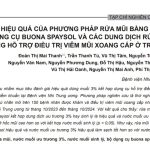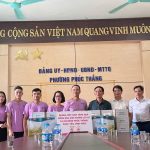
Hỏi Đáp cùng chuyên gia tư vấn BUONA
Hướng dẫn sử dụng chuyên mục hỏi đáp
Thông tin trong chuyên mục chỉ mang tính chất tham khảo, việc điều trị cần liên hệ với bác sỹ để có thông tin chính xác.
- Trước khi đặt câu hỏi mới, hãy sử dụng chức năng " Tìm câu hỏi" để tìm câu hỏi tương tự
- Sử dụng chức năng " Kiểu sắp xếp" để sắp xếp hiển thị câu hỏi theo thứ tự mong muốn
- Bấm vào nút " Đặt câu hỏi" để gửi câu hỏi.
- Việc bình luận, bình chọn sẽ giúp bạn tích điểm và được ưu tiên trả lời khi đặt câu hỏi
- Những câu hỏi, comment không phù hợp sẽ không được đăng hoặc bị xóa bởi ban Quản trị, nick comment có thể bị khiển trách hoặc xóa nick tùy theo mức độ nghiêm trọng của vi phạm.
Xin chào Buona,
Con trai tôi 2 tuổi, bé bị viêm mũi dị ứng từ bé. Hiện tại bé đã 2 tuổi nhưng thường xuyên bị viêm mũi dị ứng vào thời điểm giao mùa, hoặc mùa thu – đông. Bệnh ảnh hưởng nhiều đến khả năng hô hấp và phát triển của cháu. Vì vậy, tôi muốn sử dụng sản hẩm Nebial KIT để vệ sinh mũi cho bé hàng ngày, xin vui lòng tư vấn cách thức sử dụng?
3896 answers
Scientists have solved the mystery of a 650-foot mega-tsunami that made the Earth vibrate for 9 days
[url=https://kraken2trfqodidvlh4aa337cpzfrhdlfldhve5nf7njhumwr7insta.cc]kraken4qzqnoi7ogpzpzwrxk7mw53n5i56loydwiyonu4owxsh4g67yd[/url]
It started with a melting glacier that set off a huge landslide, which triggered a 650-foot high mega-tsunami in Greenland last September. Then came something inexplicable: a mysterious vibration that shook the planet for nine days.
Over the past year, dozens of scientists across the world have been trying to figure out what this signal was.
Now they have an answer, according to a new study in the journal Science, and it provides yet another warning that the Arctic is entering “uncharted waters” as humans push global temperatures ever upwards.
https://kraken2trfqodidvlh4aa337cpzfrhdlfldhve5nf7njhumwr7insta.cc
kraken7jmgt7yhhe2c4iyilthnhcugfylcztsdhh7otrr6jgdw667pqd
Some seismologists thought their instruments were broken when they started picking up vibrations through the ground back in September, said Stephen Hicks, a study co-author and a seismologist at University College London.
It wasn’t the rich orchestra of high pitches and rumbles you might expect with an earthquake, but more of a monotonous hum, he told CNN. Earthquake signals tend to last for minutes; this one lasted for nine days.
He was baffled, it was “completely unprecedented,” he said.
Seismologists traced the signal to eastern Greenland, but couldn’t pin down a specific location. So they contacted colleagues in Denmark, who had received reports of a landslide-triggered tsunami in a remote part of the region called Dickson Fjord.
The result was a nearly year-long collaboration between 68 scientists across 15 countries, who combed through seismic, satellite and on-the-ground data, as well as simulations of tsunami waves to solve the puzzle.
Scientists who discovered mammals can breathe through their anuses receive Ig Nobel prize
[url=https://kraken3yvbvzmhytnrnuhsy772i6dfobofu652e27f5hx6y5cpj7rgyd.cc]kraken тор[/url]
The world still holds many unanswered questions. But thanks to the efforts of the research teams awarded the IG Nobel Prize on Thursday, some of these questions – which you might not even have thought existed – now have answers.
We now know that many mammals can breathe through their anuses, that there isn’t an equal probability that a coin will land on head or tails, that some real plants somehow imitate the shapes of neighboring fake plastic plants, that fake medicine which causes painful side-effects can be more effective than fake medicine without side-effects, and that many of the people famous for reaching lofty old ages lived in places that had bad record-keeping.
https://kraken3yvbvzmhytnrnuhsy772i6dfobofu652e27f5hx6y5cpj7rgyd.cc
kra6 cc
The awards – which have no affiliation to the Nobel Prizes – aim to “celebrate the unusual, honor the imaginative – and spur people’s interest in science, medicine, and technology” by making “people laugh, then think.”
In a two-hour ceremony as quirky as the scientific achievements it was celebrating, audience members were welcomed to their seats by accordion music, before a safety briefing warned them not to “sit on anyone, unless you are a child,” not to “feed, chase or eat ducks” and to throw their paper airplane safely. There were two “paper airplane deluges” during the ceremony in which the audience attempted to throw their creations – safely – at a target in the middle of the stage.
Among those collecting their prizes was a Japanese research team led by Ryo Okabe and Takanori Takebe who discovered that mammals can breathe through their anuses. They say in their paper that this potentially offers an alternative way of getting oxygen into critically ill patients if ventilator and artificial lung supplies run low, like they did during the Covid-19 pandemic.
American psychologist B.F Skinner was posthumously awarded the peace prize for his work attempting to use pigeons to guide the flight path of missiles, while a European-wide research team was awarded the probability prize for conducting 350,757 experiments to demonstrate that a coin tends to land on the same side it started when it is flipped.
Hyundai and GM to work together on developing new cars
[url=https://kraken3yvbvzmhytnrnuhsy772i6dfobofu652e27f5hx6y5cpj7rgyd.cc]kra7 cc[/url]
Hyundai and General Motors (GM) have agreed to look for ways to work together on developing new vehicles, supply chains and technologies in an effort to cut costs and move more quickly.
Global carmakers are under intense pressure to come up with new electric vehicle (EV) and battery technology because they face vehicle emissions regulations around the world. Those research and development efforts could cost tens of billions of dollars.
They’re also facing an onslaught of potential competition from Chinese automakers, particularly EV producers, trying to export their lower-cost models overseas in order to escape a huge oversupply problem at home.
kra8 cc
https://kraken3yvbvzmhytnrnuhsy772i6dfobofu652e27f5hx6y5cpj7rgyd.cc
South Korea’s Hyundai and America’s GM (GM) said on Thursday they would collaborate on joint product development, manufacturing and future clean energy technologies. They plan to work together on internal combustion, clean-energy, electric and hydrogen vehicles.
The non-binding framework agreement was signed by Hyundai Motor Executive Chair Euisun Chung and GM Chair and CEO Mary Barra.
“Our goal is to unlock the scale and creativity of both companies to deliver even more competitive vehicles to customers faster and more efficiently,” Barra said in the statement.
Including its affiliate Kia, Hyundai Motor is the world’s third-largest automaker by sales, according to Reuters, while GM is currently America’s largest carmaker, having retaken that title from Toyota (TM) in 2022.
“This partnership will enable Hyundai Motor and GM to evaluate opportunities to enhance competitiveness in key markets and vehicle segments, as well as drive cost efficiencies and provide stronger customer value,” Chung said in the statement.
Carmakers are increasingly sealing partnerships as a way of becoming more competitive in a cut-throat industry driven by price wars.
Last year, Nissan and Renault finalized the terms of their revamped alliance, which will focus on developing EVs. GM and Honda (HMC), along with Cruise — GM’s autonomous driving subsidiary — have agreed to create a driverless ride-hailing company in Japan.
Scientists who discovered mammals can breathe through their anuses receive Ig Nobel prize
[url=https://kraken3yvbvzmhytnrnuhsy772i6dfobofu652e27f5hx6y5cpj7rgyd.cc]kra7 cc[/url]
The world still holds many unanswered questions. But thanks to the efforts of the research teams awarded the IG Nobel Prize on Thursday, some of these questions – which you might not even have thought existed – now have answers.
We now know that many mammals can breathe through their anuses, that there isn’t an equal probability that a coin will land on head or tails, that some real plants somehow imitate the shapes of neighboring fake plastic plants, that fake medicine which causes painful side-effects can be more effective than fake medicine without side-effects, and that many of the people famous for reaching lofty old ages lived in places that had bad record-keeping.
https://kraken3yvbvzmhytnrnuhsy772i6dfobofu652e27f5hx6y5cpj7rgyd.cc
kraken зеркало
The awards – which have no affiliation to the Nobel Prizes – aim to “celebrate the unusual, honor the imaginative – and spur people’s interest in science, medicine, and technology” by making “people laugh, then think.”
In a two-hour ceremony as quirky as the scientific achievements it was celebrating, audience members were welcomed to their seats by accordion music, before a safety briefing warned them not to “sit on anyone, unless you are a child,” not to “feed, chase or eat ducks” and to throw their paper airplane safely. There were two “paper airplane deluges” during the ceremony in which the audience attempted to throw their creations – safely – at a target in the middle of the stage.
Among those collecting their prizes was a Japanese research team led by Ryo Okabe and Takanori Takebe who discovered that mammals can breathe through their anuses. They say in their paper that this potentially offers an alternative way of getting oxygen into critically ill patients if ventilator and artificial lung supplies run low, like they did during the Covid-19 pandemic.
American psychologist B.F Skinner was posthumously awarded the peace prize for his work attempting to use pigeons to guide the flight path of missiles, while a European-wide research team was awarded the probability prize for conducting 350,757 experiments to demonstrate that a coin tends to land on the same side it started when it is flipped.
Trạng thái câu hỏi







